Správa továrny nebo velkého podniku není malý úkol, že? Máte stroje, které bzučí, světla a neustálou potřebu energie. Kromě toho chtějí firmy ušetřit peníze, chytře využívat energii a možná dokonce trochu pomoci planetě. Právě tam vstupují měniče a systémy pro ukládání baterií. Tyto dvě fungují jako dynamické duo, pomáhají podnikům spravovat energii, snižovat spotřebu energie ze sítě a udržovat věci hladce. V tomto článku rozložíme, jak se měniče a úložiště baterií spojují v průmyslovém řízení energie. Navíc použijeme světlo na to, jak WonVoltuNaše chytrá řešení dávají podnikům krok nahoru.
Úloha měničů a skladování baterií v průmyslových energetických systémech
Továrny potřebují spoustu energie, a to potřebuje změny po celý den. Některé hodiny, je to super zaneprázdněné; Jindy je to klidné. Středníky a akumulátorové systémy zajišťují, že je vždy dostatek šťávy, i když se poptávka zvýší nebo obnovitelné zdroje energie, jako je sluneční nebo větrné, přestávají.
Co dělají invertéry
Jáměniče jako překladatelé energetického světa. Berou stejnosměrnou elektřinu (DC), jako je to, co pochází ze solárních panelů, a mění ji na střídavý proud (AC). A proč? Protože většina továrních strojů a elektrické sítě miluje střídavé napájení.
Co dělá úložiště baterie
Navíc energie produkovaná solárními panely může být uložena v akumulátorovém systému. Budou používány, když je energie krátká. Tento systém může zvýšit stabilitu vaší energie. Může také pomoci méně spoléhat na síť.
Co je to inverter?
Invertor je jako MVP jakéhokoli energetického systému. Přeměňuje DC energie ze zdrojů, jako jsou solární panely nebo větrné turbíny, na střídavou energii, kterou mohou tovární stroje použít. Není to jen jeden trik pony. Invertory také sledují tok energie, aby se ujistily, že je pěkně sdílen v celém podniku. Žádný nepořádek, žádný nepořádek.
V továrnách jsou měniče a systémy pro ukládání baterií kamarády. Zvládnou ukládání a vysílání energie, udržují věci efektivní. Poskytováním stabilního střídavého napájení pomáhají měniče snížit odpad a provoz funguje jako dobře olejovaný stroj.
Typy měničů používaných v průmyslových aplikacích
Ne všechny invertory jsou stejné. Různé jsou vhodné pro různé pracovní místa v průmyslových odvětvích. Zde je přehled:
- String měniče: Tyto se připojí ke skupině solárních panelů připojených v řádku, nazývanému řetězec. Jsou ideální pro malé nebo střední továrny.
- Centrální měničePovažujte je za velkého šéfa obrovských průmyslových odvětví. Jeden obrovský měnič spravuje energii z tuny panelů. Jsou super efektivní, ale potřebují složitější nastavení.
- MikroinvertéryTito kluci se drží každého solárního panelu. Každý panel dělá svou vlastní věc, což je skvělé, pokud se některé panely zastíní. Jsou flexibilní a spolehlivé.

Co je úložiště baterie?
Jak funguje úložiště baterií
Zde je dohoda: akumulátorové systémy využívají chemické reakce k udržení energie. Máte navíc energii ze solárních panelů během slunečného dne? Přeměňuje se na chemickou energii a ukládá se v bateriích. Když ji potřebujete později, jako v noci, baterie přemění tuto chemickou energii zpět na elektřinu pro vaše stroje. Je to jako ukládat zbytky na večeři.
Typy baterií používaných v průmyslovém ukládání energie
Baterie jsou k dispozici v různých příchutích pro různé průmyslové potřeby. Podívejte se na tyto:
- Lithium-iontové baterieTo jsou rockové hvězdy baterií. Balí spoustu energie, poslední věky a nepotřebují moc TLC. WonVolt staví skladovací systémy lithium-iontových bateriíTo může být rozšířeno pro velké továrny.
- Olovené-kyselinové baterieToto je možnost rozpočtu. Nejsou tak tvrdé jako lithium-ionty, ale některé továrny je stále používají, protože jsou levnější. Prostě nevydrží tak dlouho.
- Protokové baterie: Tyto ukládají energii v kapalné formě. Jsou úžasné pro masivní průmyslové odvětví, protože vydrží déle a mohou držet více energie s nějakým pohyblivým prostorem.
Jak invertory a úložiště baterií spolupracují
Invertory a úložiště baterií jsou jako arašídové máslo a želé - lépe dohromady. Udělají z průmyslového řízení energie inteligentní, peněženku příjemné a dobré pro planetu.
Dynamika toku energie
Když vaše solární panely nebo větrné turbíny vytvářejí energii, měnič přemění DC na střídavý napájení. Ta energie buď jde přímo do továrny, nebo do sítě. Navíc se dostane ponožky pryč v akumulátoru. Když je poptávka vysoká nebo počasí nespolupracuje, baterie uvolňují své zásoby. Střídavý měnič zase vstoupí a přemění to DC napájení zpět na střídavý pro vaše stroje.
Tato týmová práce udržuje energii proudí bez škákání. To snižuje odpad a zajišťuje, že vaše továrna nikdy nebude suchá.
Integrované systémy řízení energie (EMS)
Velké továrny se spoléhají na systémy řízení energie (EMS), aby udržely měniče, baterie a další zdroje energie pod kontrolou. Tyto systémy jsou jako mozek operace, sledující spotřebu energie v reálném čase. Ujistí se, že nic nebude plýtvat. EMS sleduje, kolik energie vytváříte, používáte a ukládáte, přičemž upravuje věci tak, aby všechno zuřilo.
Řešení WonVolt pro ukládání energie spojují chytré měniče s silnými bateriovými systémy. Jejich nastavení zpracovává tok energie jako profesionál, pomáhá továrnám opustit síť, ušetřit peníze a zůstat zelenými.
Výhody integrace do průmyslového prostředí
Když se měniče a úložiště baterií spojí, dosahují průmyslové odvětví vážných vítězství. Zde je Scoop:
Úspora nákladů a energetická účinnost
Šetření extra energie pro rušné časy je změna hry. Vyskočíte nákup drahé síťové energie, když poptávka je přes střechu. Navíc chytré využívání energie znamená méně odpadu. To je více peněz v kapse a nižší účty.
Řekněme, že továrna ukládá solární energii celý den. V noci, když ceny sítě stoupají, používá místo toho ušetřenou energii. Postupem času se tyto úspory přidávají velké - někdy tisíce dolarů.
Stabilita a spolehlivost sítě
Invertory a baterie chrání síť před kolísáním. Začínají pracovat během špičkových hodin a vyrovnávají vzestupy a pády obnovitelné energie. Pro místa jako jsou výrobní závody nebo datová centra, kde by výpadek energie mohl způsobit katastrofu, je to obrovské.
Udržitelnost a dodržování předpisů
Obnovitelné zdroje energie s úložními systémy činí vaše podnikání zelenějším. Spálete méně fosilních paliv, což snižuje vaši uhlíkovou stopu. To není jen dobré pro planetu, ale také vám pomůže splnit nepříjemná environmentální pravidla, kterým čelí mnoho průmyslových odvětví.
Aplikace v reálném světě a případové studie
Energetická řešení WonVolt vyvolávají vlny ve skutečných podnikech. Vezměte si jednu továrnu, která nainstalovala systém WonVolt. Uložuje energii navíc během pomalých časů a používá ji během krizových hodin. Výsledek? Menší síťová energie a mnohem nižší náklady.
Pak je tu velká kancelářská budova, která spárovala systém WonVolt se solárními panely. Šetří denní energii pro noční použití, zvyšuje účinnost a dosahuje svých cílů šetrných k životnímu prostředí.
Výzvy a úvahy
Středníky a úložiště baterií jsou úžasné, ale nejsou dokonalé. Zde je několik věcí, na které je třeba dávat pozor:
- Integrace a kompatibilita systémuZískání měničů, baterií a dalších částí, aby hrály dobře, může být hádanka. Je třeba trochu práce, aby se to správně nastavilo.
- Předběžná investiceTyto systémy stojí dost penny předem. Ale věřte mi, dlouhodobá úspora stojí za to.
- Údržba a životnostBaterie a měniče potřebují pravidelné kontroly, aby zůstaly v špičkovém stavu. Baterie navíc nevydrží věčně, takže je budete muset nakonec vyměnit.
Závěr
Invertory a akumulátorové systémy jsou jádrem průmyslových a komerčních systémů pro ukládání energie. Spolupracují, aby vaše energie byla efektivnější. Použití těchto zařízení může snížit náklady a zajistit stabilní dodávku energie. Kontaktujte a sdělte WonVoltu své potřeby.
Časté otázky
Q1. Jak pomáhají měniče a akumulátorové systémy průmyslovým podnikům?
Odpověď: Umožňují vám ušetřit další energii a použít ji, když ji nejvíce potřebujete. To snižuje používání sítě, šetří peníze a dělá věci hladší.
Druhé čtvrtletí. Jaké druhy měničů se používají v průmyslových energetických systémech?
Odpověď: Máte strunové měniče, centrální měniče a mikroměniče. Správný závisí na velikosti a potřebách vašeho zařízení. WonVolt má škálovatelné měniče, které se dokonale hodí k úložišti baterie.
Třetí čtvrtletí. Můžou bateriové úložné systémy podniky učinit zelenějšími?
Odpověď: Vsadíte se! Sníží spotřebu energie z sítě a opírají se o obnovitelné zdroje energie, což snižuje vaši uhlíkovou stopu a pomáhá dosáhnout těchto ekologických cílů.

